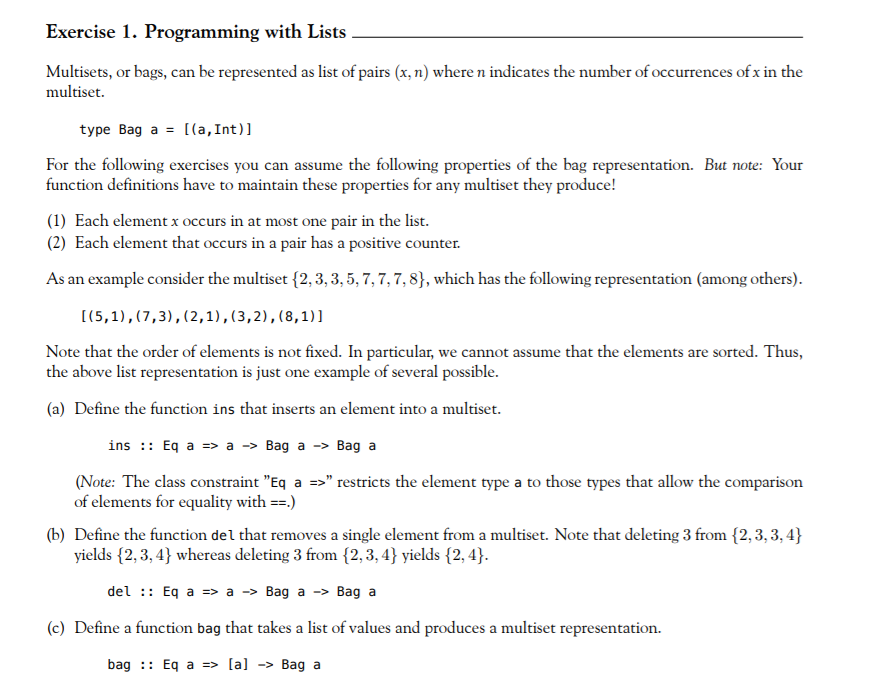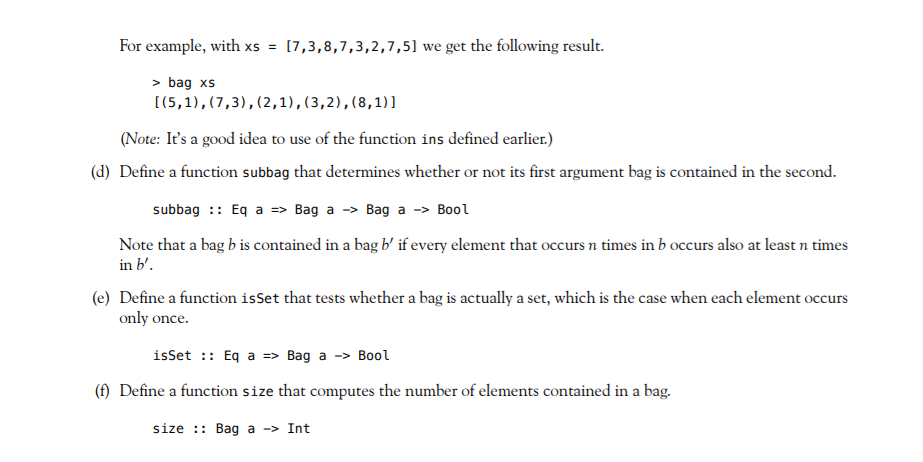Answered step by step
Verified Expert Solution
Question
1 Approved Answer
Question about Haskell. All solutions must be in Haskell . Exercise 1. Programming with Lists Multisets, or bags, can be represented as list of pairs
Question about Haskell. All solutions must be in Haskell.


Exercise 1. Programming with Lists Multisets, or bags, can be represented as list of pairs (x, n) where n indicates the number of occurrences of x in the multiset type Bag a = [(a, Int)] For the following exercises you can assume the following properties of the bag representation. But note: Your function definitions have to maintain these properties for any multiset they produce! (1) Each element x occurs in at most one pair in the list. (2) Each element that occurs in a pair has a positive counter. As an example consider the multiset {2,3,3,5,7,7,7,8}, which has the following representation (among others). [(5,1),(7,3), (2,1),(3,2), (8,1)] Note that the order of elements is not fixed. In particular, we cannot assume that the elements are sorted. Thus, the above list representation is just one example of several possible. (a) Define the function in that inserts an element into a multiset. ins :: Eq a => a Bag a > Bag a (Note: The class constraint "Eq a => restricts the element type a to those types that allow the comparison of elements for equality with ==.) (b) Define the function del that removes a single element from a multiset. Note that deleting 3 from {2,3, 3, 4} yields {2,3,4} whereas deleting 3 from {2,3,4} yields {2,4}. del :: Eq a => a -> Bag a Bag a (c) Define a function bag that takes a list of values and produces a multiset representation. bag :: Eq a => [a] => Bag a For example, with xs = 17,3,8,7,3,2,7,5] we get the following result. > bag xs [(5,1),(7,3), (2,1),(3,2), (8,1)] (Note: It's a good idea to use of the function ins defined earlier.) (d) Define a function subbag that determines whether or not its first argument bag is contained in the second. subbag :: Eq a => Bag a -> Bag a -> Bool Note that a bag b is contained in a bag b' if every element that occurs n times in b occurs also at least n times in bl. (e) Define a function isSet that tests whether a bag is actually a set, which is the case when each element occurs only once. isSet :: Eq a => Bag a -> Bool (t) Define a function size that computes the number of elements contained in a bag. size :: Bag a -> Int
Step by Step Solution
There are 3 Steps involved in it
Step: 1

Get Instant Access to Expert-Tailored Solutions
See step-by-step solutions with expert insights and AI powered tools for academic success
Step: 2

Step: 3

Ace Your Homework with AI
Get the answers you need in no time with our AI-driven, step-by-step assistance
Get Started


